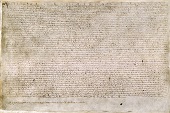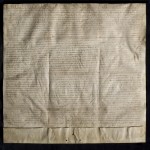 To celebrate the 800th anniversary of the signing of the Magna Carta in 1215, the British Library is bringing together all four of the surviving original copies of the iconic charter limiting monarchical authority. This is the first time in history the parchments will all be together in one place. The exact dates haven’t been released yet, but this once-in-800-years occasion will happen in early 2015 for only three days.
To celebrate the 800th anniversary of the signing of the Magna Carta in 1215, the British Library is bringing together all four of the surviving original copies of the iconic charter limiting monarchical authority. This is the first time in history the parchments will all be together in one place. The exact dates haven’t been released yet, but this once-in-800-years occasion will happen in early 2015 for only three days.
The unification will provide a once-in-a-lifetime opportunity for researchers and the public to see the documents side-by-side. 1215 adults and children will be able to enter a ballot to win free tickets to see the unified manuscripts, and the manuscripts will be examined in the British Library’s Conservation Centre by some of the world’s leading experts on the documents who are currently undertaking a major research project on Magna Carta and the charters of King John, funded by the Arts and Humanities Research Council. This unique opportunity will allow the historians involved to study faded or obscured parts of the text more closely and to look for new clues about the identity of the writers of the texts, which is hitherto unknown.
The writers were unnamed scribes working in the royal chancery. When the barons rebelling against King John forced him to concede to their terms at Runnymede on June 15th, 1215, he affixed the Great Seal to a document known as the Articles of the Barons which listed their stipulations. (This document and its Great Seal are on display in the British Library’s Magna Carta room.) Negotiations on the terms and wording continued for the next few days. Once the details were finalized, the barons swore new oaths of fealty to King John and, a month after Runnymede, the royal scribes wrote up the final terms in multiple copies known as exemplifications. Each exemplification bearing the Great Seal was distributed to signatories, bishops, sheriffs and various other officials throughout the country.
 We don’t know how many copies went out, but only four of the originals survive today, two at the British Library, one at Lincoln Cathedral and one at Salisbury Cathedral. Other Magna Cartas were issued after the first round. Between 1215 and the final edition of Magna Carta in 1297, every time a new king came to the throne or amendments were added to the original agreement new exemplifications were drawn up and distributed. There are a grand total of 17 surviving exemplifications from all the editions, most of them in England, one of them at the National Archives in Washington, D.C.
We don’t know how many copies went out, but only four of the originals survive today, two at the British Library, one at Lincoln Cathedral and one at Salisbury Cathedral. Other Magna Cartas were issued after the first round. Between 1215 and the final edition of Magna Carta in 1297, every time a new king came to the throne or amendments were added to the original agreement new exemplifications were drawn up and distributed. There are a grand total of 17 surviving exemplifications from all the editions, most of them in England, one of them at the National Archives in Washington, D.C.
The charter has come to symbolize freedoms guaranteed by law, but most of its 63 clauses aren’t statements of general legal principle but rather specific points about the administration of justice and the feudal rights of the nobility. Those questions were the core of the beef between King and barons, after all, and thus are the focus of the agreement between the factions. The vast majority of the terms were rendered obsolete over time. Only three of the clauses are still valid in English law today: one guaranteeing the freedoms of the English Church, one conferring  privileges to London and other cities, and one that looms the largest:
privileges to London and other cities, and one that looms the largest:
No free man shall be seized or imprisoned, or stripped of his rights or possessions, or outlawed or exiled nor will we proceed with force against him except by the lawful judgement of his equals or by the law of the land. To no one will we sell, to no one deny or delay right or justice.
This little clause, granted no particular emphasis or importance in the original document, has been interpreted by the courts, politicans and philosophers over the centuries as the foundation of such fundamental rights as trial by jury, due process, speedy trial and freedom from governmental caprice and excess.
Magna Carta was written in medieval Latin using copious abbreviations, as was standard practice for scribes at that time. If you’d like to read the whole thing, here’s an annotated translation of the original text.
Hey, sorry to contact you using the comment field, couldn’t find any contact info 🙂
Saw some news on a Danish site that they’ve found some Medieval stuff along with some Vikings stuff in Odense. I used Google Translate to make it a little bit more understandable, but I’m not sure I succeeded…
http://translate.google.com/translate?hl=sv&sl=sv&tl=en&prev=_dd&u=http%3A%2F%2Fekstrabladet.dk%2Fnyheder%2Fsamfund%2Farticle2043017.ece
(“Benplader” = scutes, I think)
There’s a Contact Me link on the menu at the left, third one down. Thank you for the tip. :thanks:
Aaah, found it! Thanks 😎
This is the perfect opportunity for an international epic National Treasure like movie! I mean, think about the great Masonic conspiracies Nic Cage can uncover by stealing all four copies of the Magna Carta!
IT’S MY IDEA HOLLYWOOD. CALL ME.
😎